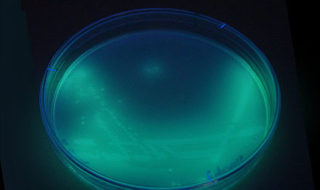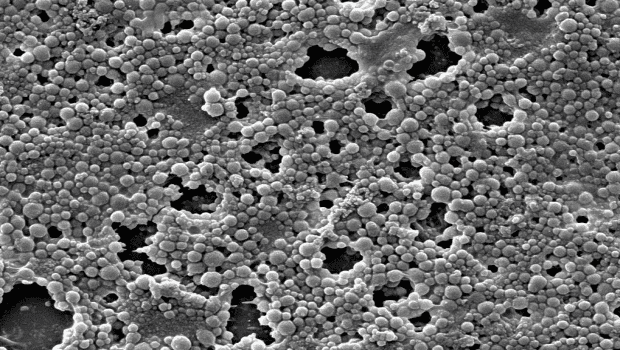It may not be a household name on the level of E. coli or Salmonella, but this troublesome bacterium is very well known. In medicine and manufacturing, Pseudomonas is high on the list of things you don’t want to have nearby. It all comes down to one particular tendency it has: like a freeloader, a rash, or that one gray hair, once Pseudomonas shows up, it simply will not go away.
Pseudomonas is a genus of gram-negative, rod-shaped bacteria which use flagella for movement. They are typically found in soil and water as obligate aerobes (needing oxygen for survival), but also colonize plant and animal tissues. A colorful group, many of them produce blue-green pigments called pyocyanins. P. fluorescens, as the name suggests, produces a pigment that even glows in the dark. In a lab setting, seeing growth media turn green is a suspicious sign that the organism may be present.

A Hospital Hazard
When it comes to Pseudomonads as pathogens, P. aeruginosa is the star of the show. It likes to spend its time in hospitals, thriving on medical equipment, such as catheters and ventilators. It will settle on a surface, get comfortable, and form a large extended family — but it won’t be content to remain there. This microbial opportunist is simply waiting for the right moment to strike.
Supervillain that it is, it has quite a few accomplishments under its belt. Pseudomonas aeruginosa alone is associated with sepsis, pneumonia, dermatitis, urinary tract infections, and infections in cystic fibrosis patients and the otherwise immunocompromised. It’s also special within its genus because it is one of the only Pseudomonads that can maintain metabolism in the absence of oxygen. This is what enables it to stay functional in damaged lung tissue.
In cystic fibrosis, a genetic disorder causes cells to produce a much thicker, more viscous mucus than is typical. In the lungs, this blocks ducts and passageways, and generally makes it difficult for the natural defenses (such as cilia) to function. This is when your opportunist sees its chance. It enters with moist air from a contaminated ventilator, or simply from unwitting, unclean hands touching your face, and settles in the altered mucus of the lung. Now it can do the thing it’s most hated for: it forms a structure called a biofilm.

Once settled, the cells rapidly reproduce and then literally stick together, releasing cellular products to form a slimy matrix. In the end, you have layers and layers of bacteria forming on top of one another until all medication can truly do is cut away at the upper surface. And if the fact that it’s so anchored wasn’t enough, along with Staphylococcus aureus and Klebsiella species, P. aeruginosa is among the best known bacteria in the world for laughing in the face of antibiotics.
As it turns out, P. aeruginosa isn’t limited to only affecting humans from within. It can be the bane of any water bottling plant. Since they tend to live in springs, wells, and other natural sources, with one small error in the process, Pseudomonas could become attached to a factory line. And once the biofilm fully establishes on the equipment, no amount of scrubbing will make it go away. Heavy-duty chemical treatment is required. Their presence can be so pervasive, that manufacturers have been known to just toss out expensive equipment, rather than waste further resources trying to rid themselves of this plague.
Silver Linings
Still, it isn’t all bad news. Many Pseudomonads have made significant positive contributions to human activity as well — from antibiotics and research opportunities to even cleaning up our messes:
P. fluorescens, can be cultured to produce an antibiotic called Mupirocin, used in the treatment of highly resistant bacterial species. It is also found around plant roots and acts to protect them from fungal growths.
P. deceptionensis lives in the Antarctic and has provided multiple avenues of interest. Strain M1T has presented with a previously unknown internal structure called a stack, meanwhile strain DC5 produces silver particles during metabolic processes.
P. aeruginosa, P. putida and a few other species can decompose hydrocarbons and are used in bioremediation. In fact, a strain of P. putida is the first organism to be patented (with much difficulty) because of its potential for use in degrading toluene and naphthalene in soil, as well as converting styrene to a biodegradable plastic, without being a threat to human health.

So, you see, even the worst of them can be used for positive things – it can break down hydrocarbons and is an excellent model for biofilm formation. As with most bacteria, the majority are harmless to humans. But it is always good to be informed and Pseudomonas is just one more thing you should know about.






